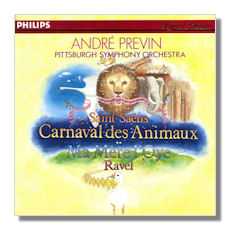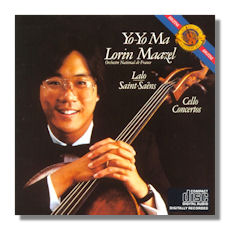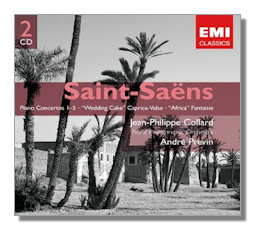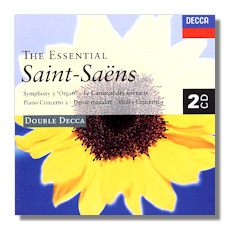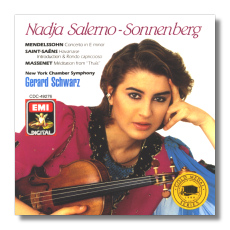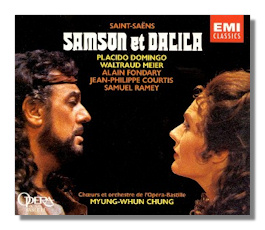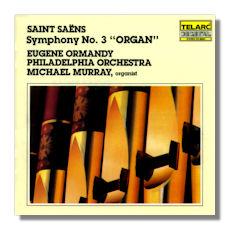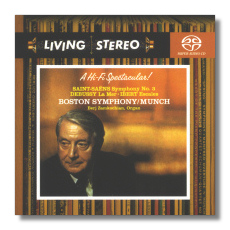
The Internet's Premier Classical Music Source
Related Links
-
Find CDs & Downloads
Amazon - UK - Germany - Canada - France - Japan
ArkivMusic - CD Universe
Find DVDs & Blu-ray
Amazon - UK - Germany - Canada - France - Japan
ArkivMusic-Video Universe
Find Scores & Sheet Music
Sheet Music Plus -
Recommended Links
Site News
Camille Saint-Saëns
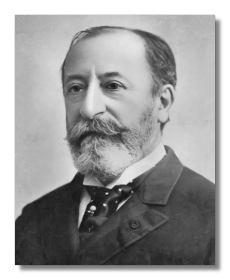
(1835 - 1921)
Living a long and full public life, Charles Camille Saint-Saëns (October 9, 1835 - December 16, 1921) experienced a wide range of reaction to his music, from admiration of his youthful talents to rejection of his early operas and finally exasperation at the extreme conservatism of his old age. Oddly enough, the work which was to make him most famous, The suite Le Carnaval des Animaux (Carnival of the Animals), was never played publicly during his lifetime.
Saint-Saëns was unusual in that he was actually born in Paris, rather than arriving there to seek his fortune. As his musical and intellectual gifts manifested themselves early, he was given his first lessons by his great-aunt, Charlotte Mason. At the age of seven he was taught piano by Camille Stamaty and theory by Pierre Maledon; the latter were essential as the boy had already begun to compose. In that same year he gave his first concert, playing the piano part in a Ludwig van Beethoven violin sonata. A recital by the 11-year-old at the Salle Pleyel preceded his induction into the Paris Conservatoire, where he initially studied organ, moving onto Halévy's composition class in 1850. It was at this point that he came to the attention of many older musicians associated with the Conservatoire and also met Franz Liszt, whose personality and music made a great impression on him. In the next few years he was a regular in Gioachino Rossini's famous Paris salon, where he met many influential people in the music world. His extreme musical facility – he could play all of Beethoven's piano sonatas from memory and his compositions were produced with little apparent effort – was a passport to later fame, but it also became a handicap, preventing him from progressing to more profound musical levels later in life.
Saint-Saëns failed to win the Prix de Rome but decided against a compulsive pursuit of the award, accepting instead the position of organist at the Church Saint-Merry. He remained there for four years before becoming organist at La Madeleine in 1858. By then he had already written, and had performed, his first and second symphonies, works which demonstrated his complete ease with symphonic form and tradition without being dramatically original in content. His remarkable piano playing, which demonstrated a due concern with musical structure and articulation as well as a remarkable fluidity of phrasing and a lucid tone, was not long neglected by his compositional activities; the First Piano Concerto, Op. 17, appeared in 1858, and the first two violin concertos quickly followed, but as yet he could not devote himself entirely to composition. In addition to his organ duties, he became piano professor at the Ecole Niedermeyer between 1861 and 1865: his two most famous pupils were Gabriel Fauré and the operetta composer, André Messager. In due course, Fauré became a close and lifelong friend.
After a second and last failure with the Prix de Rome in 1864, Saint-Saëns turned his creative attentions to opera, and with the help of Daniel-François Auber he obtained a serviceable libretto: the resultant opera, Le Timbre d'argent (1864-5) languished in manuscript until 1877. The second opera, La princesse jaune was written and premiered in 1872, receiving little reaction. His third opera, Samson et Dalila, which was first given in Weimar under the sponsorship of Liszt, had to wait until 1892 for its Paris debut. The fourth, Etienne Marcel, was coolly received in Lyons in 1879, and was not given a Paris performance.
Saint-Saëns' operatic career was severely hampered by the aversion of both opera audiences and critics to progressive music with which Saint-Saëns had become identified through his admiration for Wagner's operas. It was a different story in orchestral and instrumental music; by the end of the 1860s Saint-Saëns had created such a favorable impression that in 1868 he was awarded the Legion d'honneur. The same year his second piano concerto appeared and has remained one of his most popular orchestral pieces. The third followed in 1869, and this winning sequence was only broken by the outbreak of the Franco-Prussian War in 1870. Saint-Saëns, as one of France's most famous musicians, was regarded as particularly vulnerable, but he remained in Paris until the chaos of the Commune when he succumbed to parental pressure to leave the city. He went to London until Paris was sufficiently settled to ensure personal safety once more.
During the 1870s he began the series of European concert tours which brought him and his music into greater international prominence than any other French composer of his generation. It also brought him many distinctions and honors. Apart from his operas, he had a sure success with Danse macabre in 1874, while his superb First Cello Concerto, Op. 33, was premiered in 1873 and the fourth piano concerto in 1875, with the composer playing the soloist's part. Saint-Saëns, however, was no mere musical automaton, reluctantly churning out new works. As well as being a first-rate scholar and editor of manuscripts (he undertook a mammoth edition of all of the works of Jean-Philippe Rameau), he was an enthusiastic archaeologist and a dedicated traveler, including trips to Africa (especially Algiers), the Middle and Far East, Russia and even South America. He was also an active writer, able to produce plays as well as poetry and stories. Later in life he turned his hand to effective, if chauvinistic, journalism.
Despite all this activity, and the continued success of his music, Saint-Saëns was gradually becoming something of a misanthrope and a musical reactionary. The turning point in his life came in 1875: always deeply attached to his mother, at the age of 40 he had a whirlwind romance with the 19-year-old Marie-Laure Truffot, marrying her against his mother's wishes. From the outset the marriage was troubled, and although two sons were produced in quick succession, two domestic tragedies virtually sealed its fate: firstly, in an horrific accident, one son was killed when he fell from a fourth floor window; no more than six weeks later the second boy died of an infection from which he had been expected to recover. Devastated, and no doubt influenced by his mother, Saint-Saëns blamed Marie-Laure. The breaking point came for the composer while the couple was on holiday in 1881: he simply disappeared from their hotel and from that day on severed all connections with her. With normal relations restored with his mother, Saint-Saëns lived alone.
The 1880s were productive years for the composer. His election to the French Institute in 1881 gave him entree to all the Paris theaters, and in the next 20 years no less than nine new operas were premiered. The second violin concerto appeared in 1880, while the famous Havanaise, Op. 83 (for violin) was published in 1887. His sense of humor and his love of many avenues of knowledge may have enabled him to write the gallery of amusing musical portraits which made up Le Carnaval des Animaux (1886), but he barred any performance of the work (except "Le Cygne") during his lifetime, afraid that his public image as a serious composer might suffer from this creative chink in his armor. Ironically, it is now his most popular work. His Symphony #3 "Organ" in C minor, Op. 78 was completed in the same year as Carnaval, while his Violin Sonata #1, Op. 75, had appeared the year before, thus his mature years had produced his most popular works. His last piano concerto, premiered in 1896 and subtitled "The Egyptian", is a perfect illustration of the pleasant exoticism he could bring to orchestral music, its slow movement being a shimmering, almost motionless series of arabesques sketching an indolent afternoon in the Egyptian heat.
The remainder of Saint-Saëns' long career was equally active. He gradually became identified with the most reactionary element of the conservative musical establishment in Paris, being one of the most vociferous denouncers of Debussy and his followers. He also became progressively more xenophobic: during World War I he published essays arguing that all German music should be banned from public performance in France. But this late fallibility in judgment does not alter his position as one of the key figures in the revival if French music in the latter half of the 19th Century.

Recommended Recordings
 Carnival of the Animals
Carnival of the Animals
- "Carnival of the Animals" w/ Ravel/Philips 400016-2
-
V. & P. Jennings (pianos), André Previn/Pittsburgh Symphony Orchestra
- "Carnival of the Animals"; Septet Op. 65, Wedding Cake Op. 7, Caprice Op. 79/Erato 2292-45772-2
-
Viktoria Postnikova & Jean-François Heisser (pianos), Gennadi Rozhdestvensky/Ensemble Instrumental
- "Carnival of the Animals"; Le rouet d'Omphale Op. 31, Danse macabre Op. 40, Phaéton Op. 39/London 414460-2 or 444552-2
-
Pascal Rogé & Christina Ortiz (pianos), Charles Dutoit/London Sinfonietta
Amazon - UK - Germany - Canada - France - Japan - ArkivMusic - CD Universe
Or Double Decca 444552-2 "Essential Saint-Saëns"
Amazon - UK - Germany - Canada - France - Japan - ArkivMusic - CD Universe - "Carnival of the Animals" w/ Prokofieff & Britten/Naxos 8.550335
-
Marian Lapsansky & Peter Toperczer (pianos), Ondrej Lenard/Czecho-Slovak Radio Symphony Orchestra
Concerto #1 for Cello
- Cello Concerto #1 in A minor, Op. 33 w/ Lalo/CBS MK35848 or M2K44562
-
Yo-Yo Ma (cello), Lorin Maazel/National Orchestra Of France
Amazon - UK - Germany - Canada - France - Japan - ArkivMusic - CD Universe
Or M2K44562 w/ Schumann, Elgar, Haydn & Dvořák
Amazon - UK - Germany - Canada - France - Japan - ArkivMusic - CD Universe - Cello Concerto #1 in A minor, Op. 33 w/ Dvořák/Teldec 85340-2
-
Jacqueline Du Pré (cello), Daniel Barenboim/Philadelphia Orchestra
- Cello Concerto #1 in A minor, Op. 33/Philips 432084-2
-
Julian Lloyd-Webber (cello), Yan Pascal Tortelier/English Chamber Orchestra
Concertos #2 & 5 for Piano
- Piano Concerto #2 in G minor, Op. 22 w/ Rachmaninoff/Philips 410052-2
-
Bella Davidovich (piano), Neeme Järvi/Royal Concertgebouw Orchestra, Amsterdam
- Piano Concertos #1-5 (Complete); Wedding Cake Op. 76, Africa Op. 89/EMI 86245
-
Jean-Philippe Collard (piano), André Previn/Royal Philharmonic Orchestra
- Piano Concertos #1-5 (Complete); Wedding Cake Op. 76, Africa Op. 89, Allegro appassionato Op. 70, Rapsodie d'Auvergne Op. 73/Hyperion CDA67331/2
-
Stephen Hough (piano), Sakari Oramo/City of Birmingham Symphony Orchestra
- Piano Concertos #1-5 (Complete Works for Piano & Orchestra)/Vox Music Group CD3X3028
-
Gabriel Tacchino (piano), Louis de Froment/Orchestra Of Radio Luxembourg
- Piano Concertos #1-5 (Complete)/EMI CMS7694432 or 569258-2
-
Aldo Ciccolini (piano), Serge Baudo/Orchestra Of Paris
Danse macabre
- "Danse macabre"; Le rouet d'Omphale Op. 31, Carnival of the Animals, Phaéton Op. 39/London 414460-2 or 444552-2
-
Charles Dutoit/London Sinfonietta
Amazon - UK - Germany - Canada - France - Japan - ArkivMusic - CD Universe
Or Double Decca 444552-2 "Essential Saint-Saëns"
Amazon - UK - Germany - Canada - France - Japan - ArkivMusic - CD Universe - "Danse macabre", Op. 40; Symphony #3, etc./BIS CD-555
-
James DePreist/Royal Stockholm Symphony Orchestra
- "Danse macabre", Op. 40; Phaéton Op. 39, Le Rouet d'Omphale Op. 31, Introduction & Rondo Capriccioso Op. 28, Havanaise Op. 83, La jeunesse d'Hercule Op. 50, Marche héroïque Op. 34/London-Decca Jubilee 425021-2
-
Charles Dutoit/London Philharmonia Orchestra
 Introduction & Rondo Capriccioso
Introduction & Rondo Capriccioso
- Introduction & Rondo capriccioso, Op. 28; Poème Op. 25, Havanaise Op. 83, Tzigane/EMI CDC7477252
-
Itzhak Perlman (violin), Jean Martinon/Orchestra Of Paris
- Introduction & Rondo capriccioso, Op. 28; Havanaise Op. 83 w/ Mendelssohn & Massenet/EMI CDC7492762
-
Nadia Salerno-Sonnenberg (violin), Gerard Schwarz/New York Chamber Symphony
- Introduction & Rondo capriccioso, Op. 28; Phaéton Op. 39, Le Rouet d'Omphale Op. 31, Danse macabre Op. 40, Havanaise Op. 83, La jeunesse d'Hercule Op. 50, Marche héroïque Op. 34/London-Decca Jubilee 425021-2
-
Kyung-Wha Chung (violin), Charles Dutoit/Royal Philharmonic Orchestra
Samson et Dalila (opera)
- Samson et Dalila, Op. 47 (1877)/EMI CDS754470-2 or 509185-2
-
Plácido Domingo (tenor), Waltraud Meier (mezzo soprano), Daniel Galvez-Vallejo (tenor), Alain Fondary (Bass), Samuel Ramey (bass), Jean-Phillipe Courtis (baritone),
Christian Papis (baritone), François Harismendy (baritone) , Myung-Wha Chung/Orchestre et choeurs de l'Opéra-Bastille
Amazon - UK - Germany - Canada - France - Japan - ArkivMusic - CD Universe
Or reissued as 509185-2
Amazon - UK - Germany - Canada - France - Japan - ArkivMusic - CD Universe - Samson et Dalila, Op. 47 (1877)/EMI CDM747895-2 or 67602-2
-
Rita Gorr (mezzo soprano), Jon Vickers (tenor), Ernest Blanc (baritone), Anton Diakov (bass), Rémy Corazza (tenor), Jacques Potier (tenor), Jean Pierre Hurteau (bass), Georges Prêtre/Paris Opera Orchestra & René Duclos Chorus
- Samson et Dalila, Op. 47 (1877)/Opera d'Oro OPD-1405
-
Jon Vickers (tenor), Oralia Dominguez (mezzo soprano), Ernest Blanc (baritone), Henk Drissen (bass), Peter Van der Bilt (baritone), Bert Van t'Hoff (tenor), Aad de Rijk (tenor), Jean Fournet/Netherlands Radio Symphony & Chorus
 Symphony #3 "Organ"
Symphony #3 "Organ"
- Symphony #3 "Organ" in C minor, Op. 78/Telarc CD-80051 or CD-80634
-
Michael Murray (organ), Eugene Ormandy/Philadelphia Orchestra
Amazon - UK - Germany - Canada - France - Japan - ArkivMusic - CD Universe
Or reissued with Encores à la française on CD-80634
Amazon - UK - Germany - Canada - France - Japan - ArkivMusic - CD Universe
Or reissued with Encores à la française on Hybrid Stereo SACD-60634
Amazon - UK - Germany - Canada - France - Japan - ArkivMusic - CD Universe - Symphony #3 "Organ" in C minor, Op. 78 w/ Poulenc/London 410201-2
-
Peter Hurford (organ), Charles Dutoit/Montréal Symphony Orchestra
- Symphony #3 "Organ" in C minor, Op. 78 w/ Debussy & Ibert/RCA Living Stereo 61500
-
Berj Zamkochian (organ), Charles Munch/orchestra
Amazon - UK - Germany - Canada - France - Japan - ArkivMusic - CD Universe
Or Hybird Multichannel SACD RCA 82876-61387-2
Amazon - UK - Germany - Canada - France - Japan - ArkivMusic - CD Universe
Or JVC XRCD2 JVCXR-0002-2
Amazon - UK - Germany - Canada - France - Japan - ArkivMusic - CD Universe - Symphonies #1-3 "Organ" (Complete)/EMI CZS7626432
-
Bernard Gavoty (organ), Jean Martinon/Orchestra National de l'ORTF














